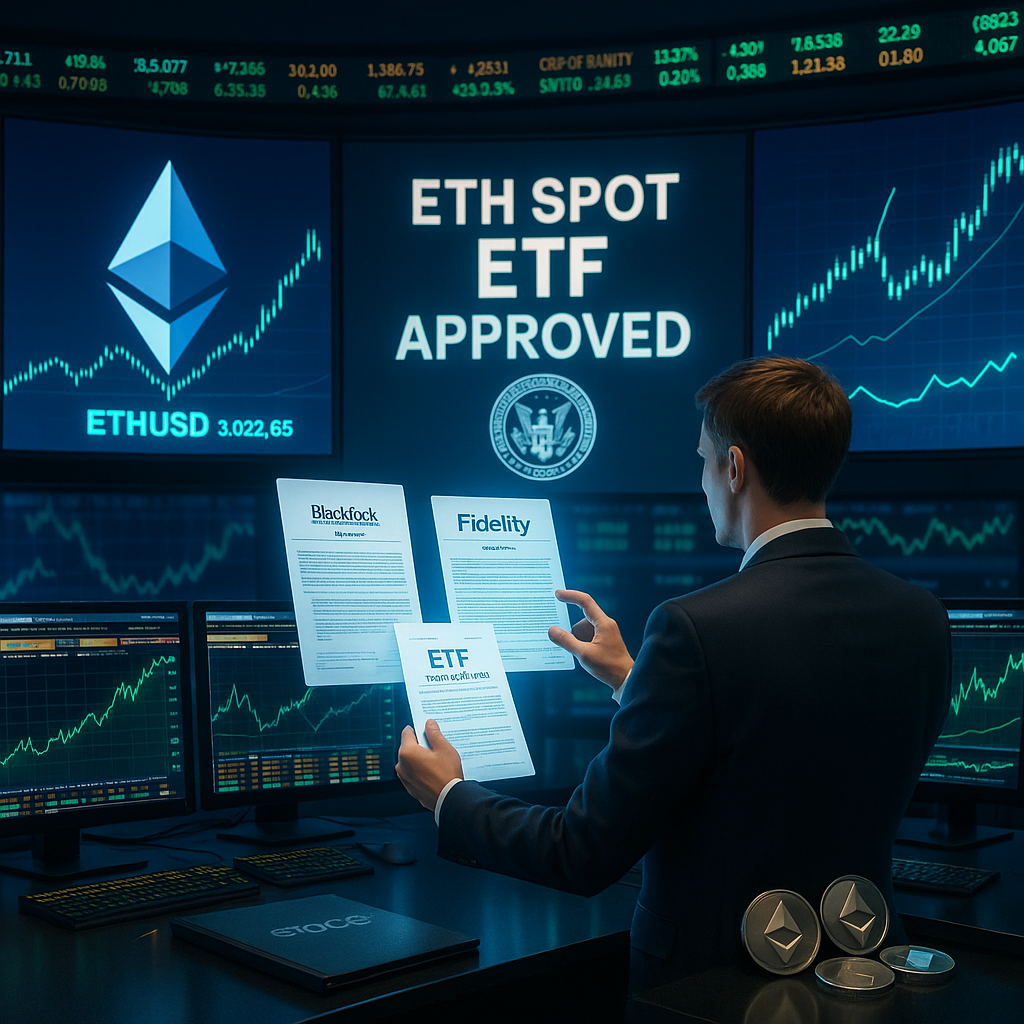Key Takeaways
- Ethereum Spot ETFs Approved: U.S. regulators have approved spot Ethereum ETFs, allowing traditional investors to purchase shares directly linked to Ethereum’s price.
- Price Approaches Record High: Ethereum briefly traded near its November 2021 peak, driven by enthusiasm following the ETF announcement.
- Wall Street Embraces Crypto: The ETF approval indicates that Ethereum is gaining recognition as a legitimate asset class within traditional finance.
- Access Simplified for New Investors: Spot ETFs enable investment in Ethereum through regular brokerage accounts, eliminating the need for direct crypto custody or specialized wallets.
- Institutional Demand Expected to Rise: Experts anticipate increased inflows from pension funds, asset managers, and other large investors.
- Next Steps: Market observers expect ETF trading to start in the coming weeks after final preparations by issuers and exchanges.
Introduction
Ethereum approached its all-time high this week after U.S. regulators approved the first Ethereum Spot ETFs on Wednesday. This decision allows traditional investors to access Ethereum through standard brokerage accounts. The move marks a significant step toward mainstream financial acceptance. It creates new opportunities for both newcomers and institutional investors as ETF trading is expected to start soon.
Market Impact and Price Movement
Ethereum’s price rose more than 10% after the spot ETF approval, reaching $2,950. That’s its highest level since 2022. Trading volumes across major exchanges doubled within hours of the news, reflecting strong institutional interest.
Major financial institutions, including BlackRock, Fidelity, and seven others, received authorization to launch Ethereum spot ETFs. Collectively, these firms represent more than $20 trillion in managed assets. Market analysts believe this expanded accessibility will spur sustained demand.
Traditional finance professionals are highlighting Ethereum’s broader utility. Sarah Chen, chief investment strategist at Capital Research Group, stated that, unlike Bitcoin, Ethereum serves as the foundation for many financial applications and services.
Stay Sharp. Stay Ahead.
Join our Telegram Group for exclusive content, real insights,
engage with us and other members and get access to
insider updates, early news and top insights.
 Join the Group
Join the Group
How Spot ETFs Change the Game
The approval of Ethereum spot ETFs introduces a marked change in how investors can gain exposure to cryptocurrency. Through these ETFs, individuals can purchase shares that directly track Ethereum’s price using their existing brokerage accounts, similar to buying stocks.
Previously, purchasing Ethereum required a crypto exchange account and a digital wallet. Spot ETFs remove these technical barriers and add familiar safeguards, such as SEC oversight and regulated custody.
Investment firms will acquire and hold actual Ethereum to back these funds. This direct ownership ensures that ETF prices stay closely aligned with Ethereum’s market value. This is quite different from futures-based ETFs that only track price movements through contracts.
What This Means for Investors
Ethereum spot ETFs open new possibilities for traditional investors. Retirement accounts, such as 401(k)s and IRAs, can now potentially include Ethereum exposure. Financial advisors are able to incorporate the asset into client portfolios more easily.
Institutional investors benefit from reduced custody issues and simplified regulatory compliance. David Martinez, director of digital assets at Global Investment Partners, noted that these products address many operational challenges that previously kept pension funds and endowments from participating in crypto markets.
Despite these advantages, financial professionals caution that Ethereum remains a volatile asset. Standard investment principles, including diversification and careful risk management, continue to apply regardless of the new access method.
Technical Infrastructure and Security
Leading ETF providers have collaborated with established crypto custodians to secure the underlying Ethereum holdings. These measures involve multi-signature protocols, cold storage solutions, and regular third-party audits.
The custody infrastructure benefits from lessons learned with Bitcoin ETFs. There are also added adjustments for Ethereum’s staking features. Providers must maintain sufficient liquid Ethereum to facilitate ETF share creation and redemption, and may generate additional returns through staking practices.
Each approved ETF issuer has disclosed comprehensive security protocols and emergency procedures in regulatory filings, addressing concerns about potential theft or loss of Ethereum holdings.
Regulatory Framework and Compliance
The SEC’s approval entails specific standards for price transparency, market surveillance, and investor protection. ETF providers are required to work with multiple regulated crypto exchanges to ensure precise price discovery and to discourage market manipulation.
Unlike the 24/7 operation of crypto markets, trading for these ETFs will be limited to regular market hours. This structure helps align Ethereum exposure with traditional investment practices while offering familiar trading patterns for institutions.
The regulatory framework also mandates continued reporting and disclosure. This gives investors standardized information on fund operations and asset management.
Conclusion
The introduction of Ethereum spot ETFs reduces technical barriers and adds new layers of regulatory oversight, making Ethereum more accessible to traditional investors. This development supports the integration of crypto assets into mainstream finance and retirement strategies. What to watch: the performance of Ethereum spot ETFs in their initial trading sessions and the pace of adoption by institutional and retail investors.





Leave a Reply